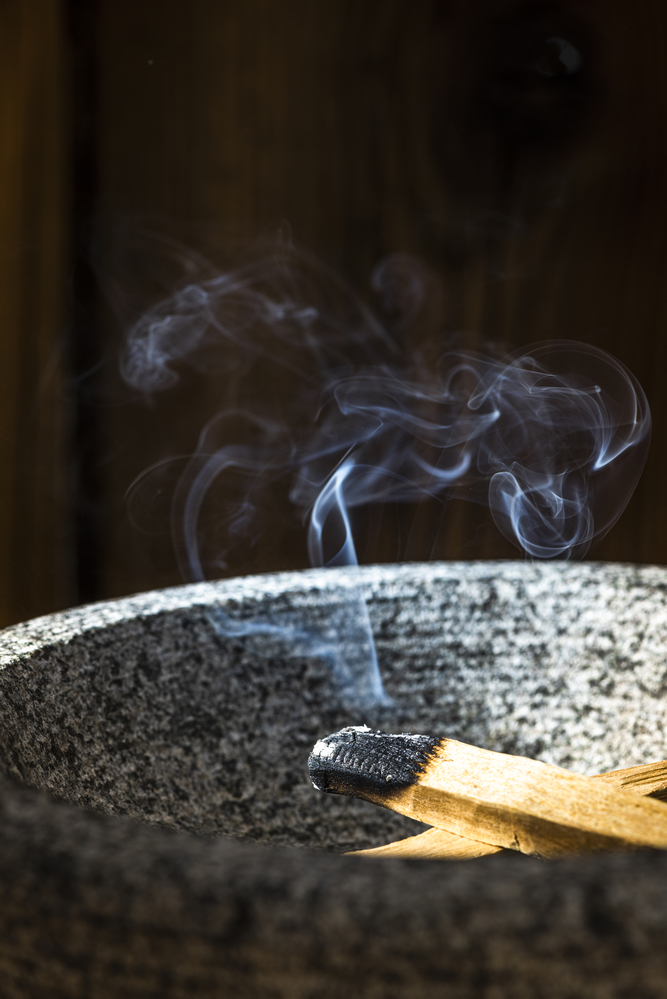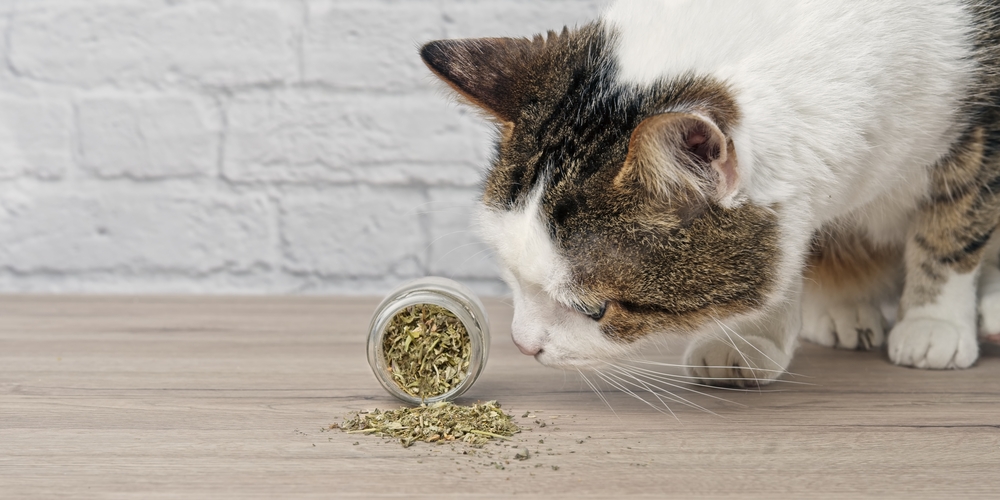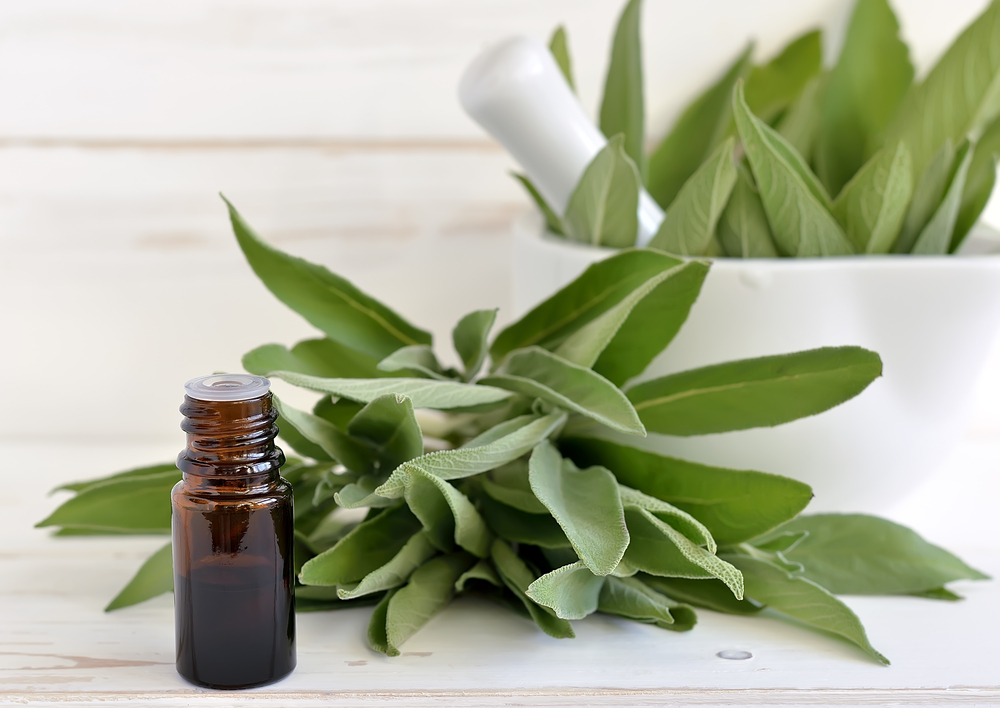
Most of us like the feeling that a bubble bath or a glass of wine while sitting on the couch, eventually combined with aromatherapy, gives us when we are stressed. This form of relaxation that can help us relieve stress consists of burning incense sticks or scented candles, using essential oils or bath salts, and more.
A typical scented stick consists of bamboo wood to which a fragrant powder of plants adheres. The scent of this wood has notes of mint, citrus, and pine and is used for relaxation and purifying our space. Still, there are also ready-to-burn, such as Palo Santo or “holy stick” (Bursera graveolens).
Raw Palo Santo wood is not toxic for cats if a feline nibbles it. When it is burning, exposing them to the smoke can irritate their lungs. Palo Santo’s only advantage is that it is an excellent natural insect repellent.
While Palo Santo is safe for cats, direct inhalation or ingestion can cause respiratory and digestive issues. Using it around cats ensures good ventilation and keeps it out of reach. Contact your vet if your cat experiences any discomfort.
The majority of essential oils are bad for your cat. Still, some are considered safe, like lavender, copaiba, helichrysum, and frankincense oil.
It is advisable to use essential oils when the cat is not around because they are concentrated plant extracts, and most are harmful to our fluffs, including Palo Santo.
Short description of Palo Santo

A Palo Santo tree is native to South America and belongs to the citrus family. It usually comes from tree branches, so it is 100% natural. The wood of the Palo Santo is available in the form of sticks, chips, or powder. It also contains a fragrant resin that can be extracted and used separately. Palo Santo essential oil analysis showed that the main active constituents are limonene 89.33%, α-terpineol 11%, menthofuran 6.6%, and carvone 2%.(1)
The wood of the saints was used by indigenous people for spiritual ceremonies and healing – to relieve the symptoms of colds and flu, depression, emotional pain, and other ailments. It is said that its aroma induces relaxation and leads to meditation, but it also brings creativity and luck.

These benefits only exist when a Palo Santo tree dies naturally and then is allowed to decompose in five to eight years. In these years, the oil in the wood matures completely before being harvested and processed (this is why it is so expensive).
Palo Santo – Risks and Benefits for Cats
Risks
Although Palo Santo is not poisonous to cats if they nibble it a bit, it contains d-limonene (a terpene found in most citrus peels), which is toxic. Depending on the concentration at which the pet is exposed (if it ingests wood or essential oil), according to the researchers, d-limonene poisoning shows the following clinical signs:
- short or long-term hypersalivation,
- digestive disorders,
- ataxia,
- shiver-like muscle tremors,
- severe hypothermia,
- irritation of the mouth,
- and even death. (2)
This toxicity is due to the lack of the liver enzyme glucuronyl transferase – a compound that helps to eliminate the substances found in many essential oils, such as phenols, eugenols, and d-limonene, that cats do not have.
Also, wood consumption can lead to intestinal blockages once it reaches the digestive tract.
Exposure to smoke from burning Palo Santo wood (and smoke in general) can cause respiratory problems. Furthermore, its inhalation may result in irritation of the mouth and gums.
If cats with skin allergies come in contact with Palo Santo by ingesting the wood or essential oil, rubbing against the tree bark, or are in a room full of smoke, it can exacerbate their allergy.
Palo Santo essential oils are obtained by distilling fallen branches and dead trees. This unique chemistry does not occur when the trees are cut down. In other words, Palo Santo essential oil is a concentrated wood essence; therefore, it will have considerably higher amounts of d-limonene, which makes it unsafe for cats. Exposure to essential oils can irritate the whole body.
It is recommended to keep Palo Santo wood away from your cat’s prying eyes and sharp teeth. If you burn a stick occasionally, doing it in a ventilated room is best.
Also, if you think your cat has ingested wood or has been exposed to essential oil or smoke, go to the vet’s office immediately with your pet.
Benefits
For some cats, Palo Santo wood stimulates play. They will nibble on it, purr, meow, and rub their head against it.
It is a good idea not to let your cat ingest it due to the medical complications that may occur later.
Do cats like the scent of Palo Santo?

While some cats like the smell of Palo Santo wood and love to stick their teeth in it, others do not react very well due to its content in d-limonene. But due to this compound toxicity, keeping your Palo Santo sticks away from your cat when burning is best because cats are sensitive to smoke.
Is burning Palo santo sticks Safe for my cat?

Burning Palo Santo wood won’t kill your cat unless you set your house on fire! On the other hand, the smoke can cause asthma attacks and irritate the oral cavity and lungs.
Lighting a stick occasionally in a ventilated room will affect your cat in any way.
To be sure your cat will be fine, burn the Palo Santo sticks away from your beloved pet!
Is Palo Santo spray/diffuser ok for my cat?
It is recommended not to use Palo Santo spray or a diffuser when your cat is nearby. The best you can do is to use it when the cat is not around and let it sit for a while.
What About other Aroma Sticks and Oils?
Whether you use burning aroma sticks, essential oils, or diffusers, it is best to do this when the cat is in another room, as it can cause your pet all sorts of reactions.
If your feline suffers from respiratory problems or skin allergies, it is recommended not to use any essential oils or aroma sticks at all because its health will deteriorate.
Are cats allergic to Palo Santo?
Like any other ingredients, you will know if your pet is allergic to something only when it comes in contact with it, and Palo Santo makes no exception!
Suppose your cat already has a skin allergy. In that case, it is better not to use incense sticks in its presence, as it can exacerbate its skin condition.
Custom stuffed animals of your petIf your pet has asthma, try not to burn Palo Santo sticks or expose it to any other smoke because it can cause an asthma attack.
Which cat breeds are most affected by incense smoke?
In general, short-nosed cat breeds are the most affected by smoke. They have shorter facial bones, and the soft tissues are modified- for this reason, the Persian, Himalayan, and Burmese breeds are the best known to have respiratory problems.
What should I do if my cat came in contact with Palo Santo?
If your cat inhales too much smoke from your burning incense, ventilate the room, move it to a smoke-free area, open the windows, or take it outside for fresh air. If you see any unusual behavior (sneezing too much, drooling, or showing signs of an asthma attack), take your pet to the veterinarian as soon as possible.
If your cat overate wood or has ingested essential oil and you see it trembling, vomiting, hyper-salivating, or it does not coordinate its movements, take it to the veterinary clinic for the proper treatment and care.
Is Palo Santo similar to catnip?

These two plants are unrelated, but some cats react to Palo Santo as they do to catnip.
Cats will bite the wood, purr, meow, rub their face against it, and they will want to play – this is why it is said that Palo Santo stimulates play.
Palo Santo Vs. Sage

Unlike Palo Santo, sage is safe for cats (along with basil) – cats can ingest it without any toxic effects. However, be careful not to expose your kitty to the essential oils (either directly or through a diffuser). As we mentioned at the beginning of the article, cats lack the liver enzyme that breaks down chemicals found in essential oils, so even a low dose can be considered harmful.
Is Peppermint or Patchouli Incense Safe For my Fluffy Pets?

The peppermint plant is considered poisonous to cats – skin exposure and ingestion can be toxic for our felines. It is poisonous whether applied directly to the skin, used in diffusers, or a drop licked from the ground. Therefore, do not use peppermint incense sticks or essential oils, as they harm your cat.
The Patchouli plant is related to mint (like catnip) but is unsafe for cats. Mint-based essential oils and aromas contain chemicals too strong for our little cats, making them difficult for their bodies to process.
Unlike peppermint, Patchouli is not considered toxic, but the likelihood of substantial side effects on your cat’s health is high.
Can I use air fresheners for my cat?
In general, air fresheners are composed of over 100 chemicals, including volatile organic compounds (such as limonene) – so it is recommended to use them when your cat is not in the room. Do not apply it to your pet or let your cat lick the product!
It is best to use pet-friendly air fresheners, such as Feliway, Enviroscent Plug-in Air Freshener Kit, Mrs. Meyer’s Room Freshener, and others because they contain natural fragrances.
Are scented candles safe for my cat?

Cats have a very sharp sense of smell, and the strong scents bother most of them; therefore, they may avoid rooms where fragranced candles are used. However, if your cat is nearby, ensure the room is well-ventilated so that the fumes and smell of the candle do not cause problems for your pet.
Regardless of the candle type (natural or artificial, scented or not), there is always the risk that your cat will flip it and burn itself or even set the house on fire. So, be careful!
Best and Worst essential oils and incense sticks for Cats
No matter what essential oil you choose to use, all of them have the potential to be dangerous to our cats, but some are considered safer, such as:
- lavender,
- copaiba,
- helichrysum,
- jasmine,
- cedarwood,
- vetiver,
- eucalyptus,
- and frankincense oil.
It is best to use them in a diffuser, as they are very dilute this way.
Cats should avoid the following plants or essential oils:
Peppermint – raw peppermint and essential oil are poisonous to cats because it contains phenols, which are very harmful to our little felines.
Lemongrass – raw lemongrass is safe for cats, but in small quantities; Lemongrass essential oils can be fatal to cats.
Tea tree essential oil can be poisonous to cats if it is not diluted or if the dose is too high (before it is applied to the skin). Although tea tree oil was once considered a safe remedy for fleas, it is now recommended not to use it in cats.
Lavender plants and essential oils are toxic to cats if ingested and can cause nausea and vomiting.
Chamomile, in small doses, is considered relatively safe for cats. Still, ingested in large quantities or long-term can harm your cat. It contains many toxic substances for our little felines, such as tannic acid, anthemic acid, chamazulene, bisabolol, and volatile oils.(3)
Rosemary – although fresh rosemary leaves can’t cause any damage to cats, the essential oil is harmful to them.
Thyme – like peppermint, contains phenols that are dangerous to your cat and can make it sick.

Other harmful essential oils for cats include vanilla, lemon, orange, grapefruit, rose, thieves, oregano, bergamot, and others.
Cinnamon and clove are considered both as toxic as peppermint.
Please Pin and Share our Quick Overview!

Conclusions
Whether we are talking about Palo Santo essential oil or anything other, remember that most of them are harmful to your cat because our pets lack a liver enzyme that helps eliminate these toxic substances.
Palo Santo contains d-limonene, a terpene that is toxic to your cat. Therefore, keeping Palo Santo wood away from your cat’s curious eyes is a good idea.
As for incense sticks, the smoke they emit can cause your cat to have respiratory problems and even asthma attacks.
If your cat has skin allergies, you must avoid essential oils as they may amplify their medical conditions.
High-concentrated essential oils or continued exposure to smoke can be dangerous for cats. It is best to avoid using them around your fluffy pets and use them in well-ventilated rooms.
I hope our article answered all your questions about your curious cat, incense sticks, and essential oils.
Please Share Your Thoughts In The Comment Section Below!
Happy Cat Care!
